It is no easy feat to make the transition from academy to first-team football, and even more so when you are a goalkeeper.
This, however, is precisely what former Manchester United youth keeper Dean Henderson did when he took the reins from David De Gea in the United goal.
After impressing in loan spells at EFL League One side Shrewsbury and back-to-back seasons at Sheffield United, Henderson was vocal in stating his desire to become the number-one choice at Old Trafford.
He grasped the opportunity to do so in the 2020/21 season, recording 12 clean sheets from 26 matches in all competitions.
Despite assurances that he would be the United number one for the following campaign, he predominantly featured on the bench, much to Henderson’s frustration.
The Cumbrian-born keeper continued expressing his desire to play regularly and secured a loan switch to then-newly promoted Nottingham Forest for the 2022/23 season.
Injury cut short his campaign in January 2023, but he impressed at the City Ground.
The East Midlands side tried to make the deal permanent in the recent transfer window, but United were reluctant to sell without a replacement brought in first.
Forest subsequently opted for Arsenal’s Matt Turner, and Henderson had to wait towards the end of the window to finalise his move away from the north-west.
Henderson eventually moved to Premier League side Crystal Palace for a reported £20 million fee.
However, interestingly, it is not a foregone conclusion that Henderson will be the first-choice keeper for the Eagles.
The present holder of the number one jersey at Palace is current England international Sam Johnstone, who, like Henderson, is a product of the Manchester United academy.
In further parallels, Johnstone has also plied his trade in the lower divisions on loan spells.
In this tactical analysis, we will analyse the performance of the current first choice, Johnstone, to determine why he is the preferred option in goal.
This analysis will look at the statistics from previous seasons to compare the two goalkeepers at the disposal of Palace boss Roy Hodgson.
We will also analyse the possession attributes of Johnstone and Henderson to determine whether they conform to Palace’s tactics.
Johnstone, the current first-choice
When Hodgson arrived back at Selhurst Park for his second stint as manager, Palace were in freefall.
They had failed to win in their previous 12 league matches.
During this 12-game period, prior to Hodgson’s arrival, the South London side had been conceding 1.42 goals per match.
The former England manager was able to guide his side to five wins, and three draws from the remaining 10 matches to secure the club’s Premier League survival.
Furthermore, Palace reduced their goals against rate during this time and were conceding 1.1 goals per match following Hodgson’s appointment.
Hodgson didn’t vary much from his predecessor, Patrick Vieira, with his chosen back four.
However, the veteran manager did opt to change his goalkeeper as Johnstone’s introduction to the matchday line-up coincided with the reappointment of Hodgson.
Johnstone made an immediate impact in his first league match, in which the Eagles defeated Leeds United 5-1.
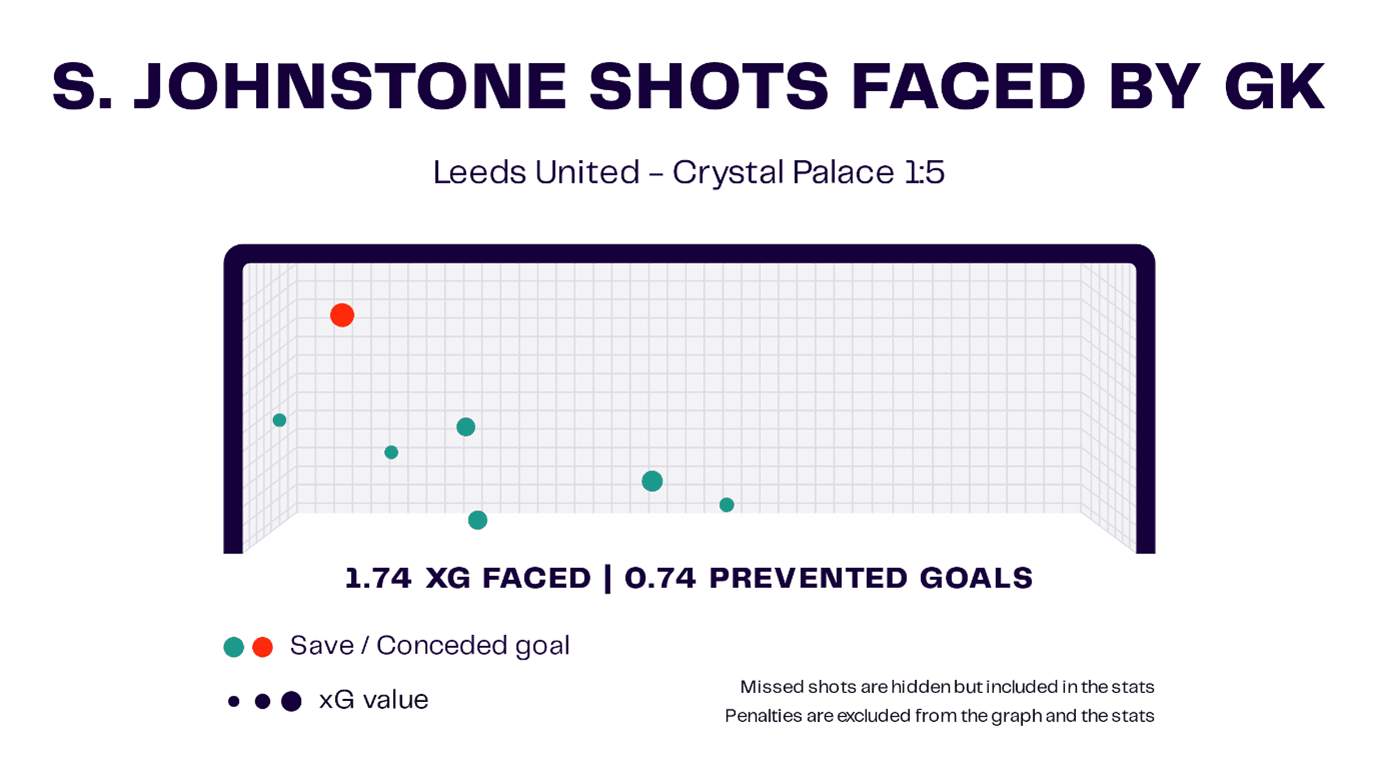
The graphic shows that Johnstone saved 85% of the shots on target at Elland Road.
All of these saves came in the first half prior to Palace’s equaliser on the stroke of half-time.
Palace were then able to dominate the second half and would go on to win the game.
It is demonstrated that Johnstone’s performance enabled Palace to keep a foothold in the match and record a vital victory.
In the 2022/23 season, Johnstone made nine league appearances and kept three clean sheets.
Therefore, his 33.3% clean sheets equalled Henderson’s percentage of clean sheets at Forest last season.
When comparing with goalkeepers who had played in at least nine league games, only five goalkeepers recorded higher rates than the current Palace keepers last season.
Following on from his impressive displays at the end of last season, Johnstone retained his place in the Palace starting XI for the current campaign.
Palace boast one of the best defences in the league this season, conceding 1.17 goals per match and 0.83 non-penalty goals per match.
Moreover, compared to other goalkeepers this 2023/24 season, Johnstone’s performances in goal have been above the average.
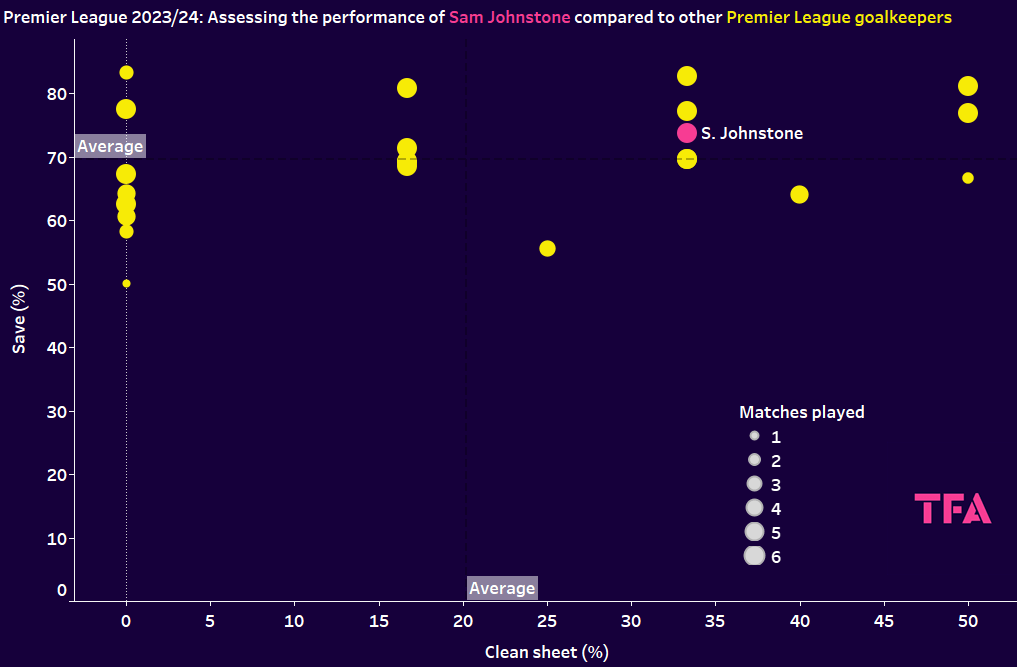
The scatter plot shows Johnstone has saved 73.7% of shots and kept a clean sheet in 33.3% of matches.
This is above the average save percentage of 69.6% and the average clean sheet percentage of 20.2%.
Furthermore, Johnstone currently ranks in the top five in the division for percentage of clean sheets.
These impressive figures suggest Henderson may have a difficult task ahead in displacing Johnstone.
Nevertheless, Johnstone has so far only prevented 0.42 goals this campaign.
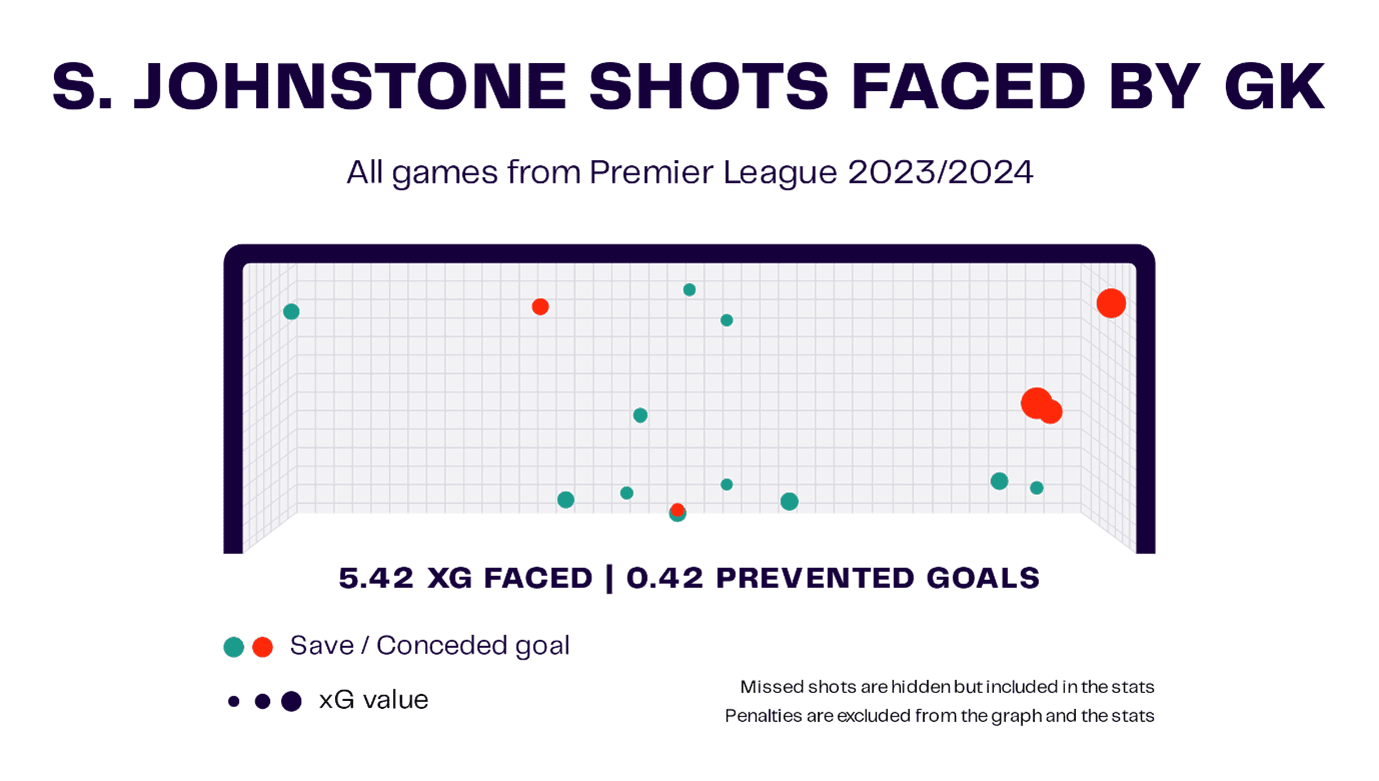
The graphic shows that Johnstone has conceded goals with low expected goal values.
This indicates an underperformance at times from the England international.
The 30-year-old will look to improve this aspect as the season progresses.
Nonetheless, only Manchester City and Arsenal have faced fewer shots on target in the division this season.
This suggests the strong organisation of the Palace defence, spearheaded by Johnstone.
Head-to-head through the seasons
When Henderson went out on loan for experience in the earlier stages of his career, he impressed.
Henderson was named in the EFL League One PFA Team of the Year in 2018, as Shrewsbury reached the finals of the EFL trophy and the playoffs.
The 26-year-old was also named the Blades Young Player of the Year in 2019 as Sheffield United won promotion from the EFL Championship.
During the 2018-19 season, Henderson won the Championship Golden Glove award, having kept 21 clean sheets.
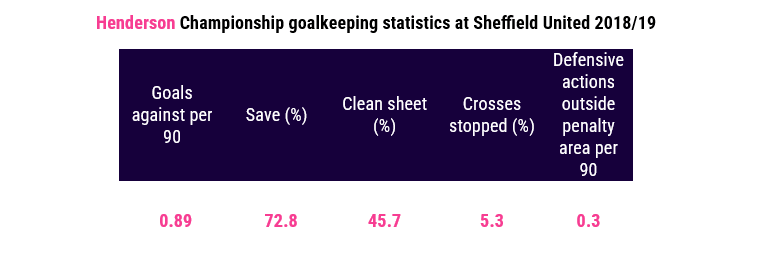
Only three other goalkeepers conceded fewer goals per 90 minutes in the EFL Championship that season, and only Sheffield Wednesday’s Keiren Westwood had a higher percentage of clean sheets in the league.
Given Henderson was part of a promotion-winning side that season, it is somewhat unsurprising that he had such impressive statistics.
However, Henderson was the lowest-ranked keeper in the division that season for defensive actions outside the penalty area per 90.
On the other hand, Johnstone was ranked in the top three goalkeepers for the same statistic whilst playing for West Brom.
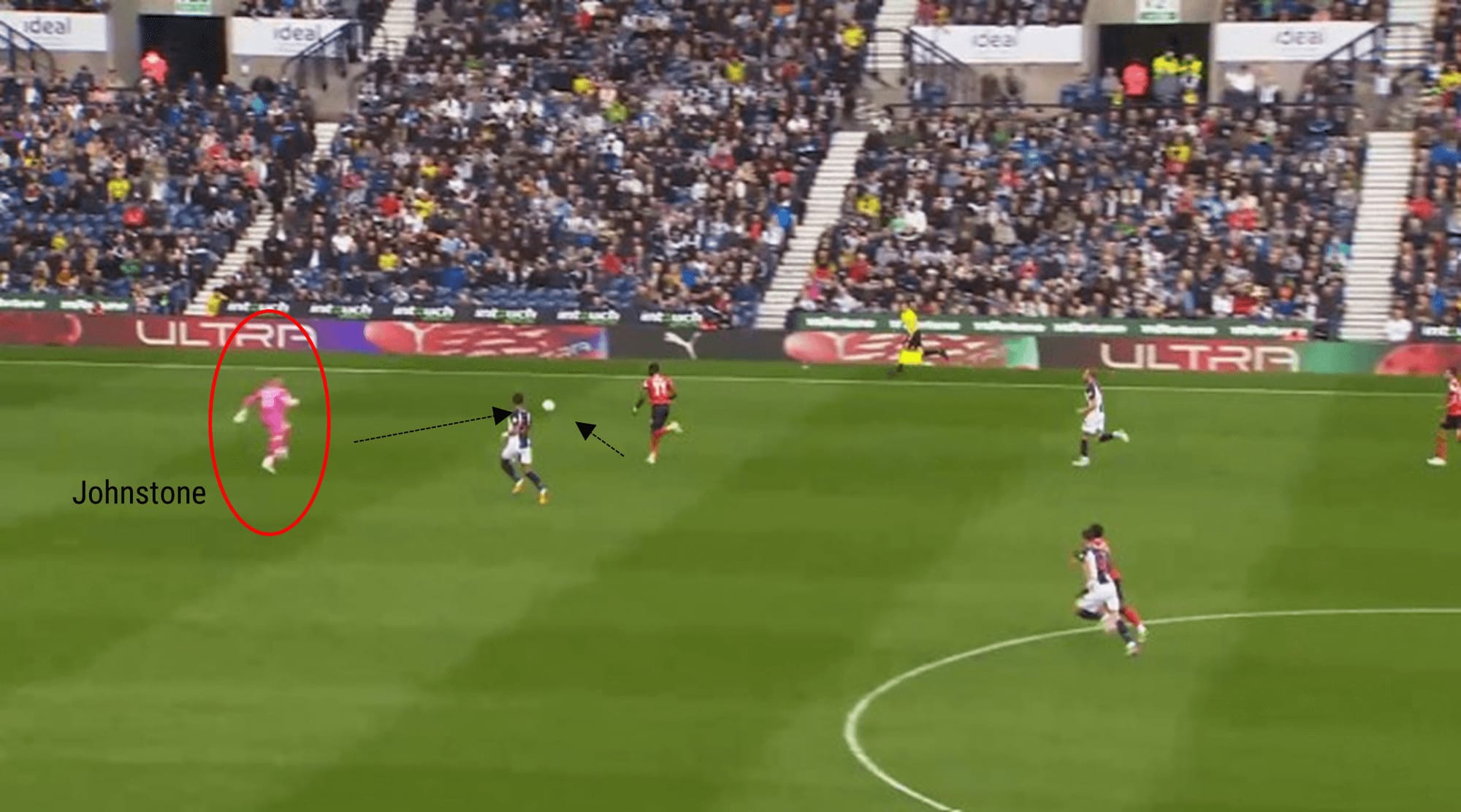
In the match still, Johnstone has advanced far from his penalty area with the intention of preventing Luton from breaking away.
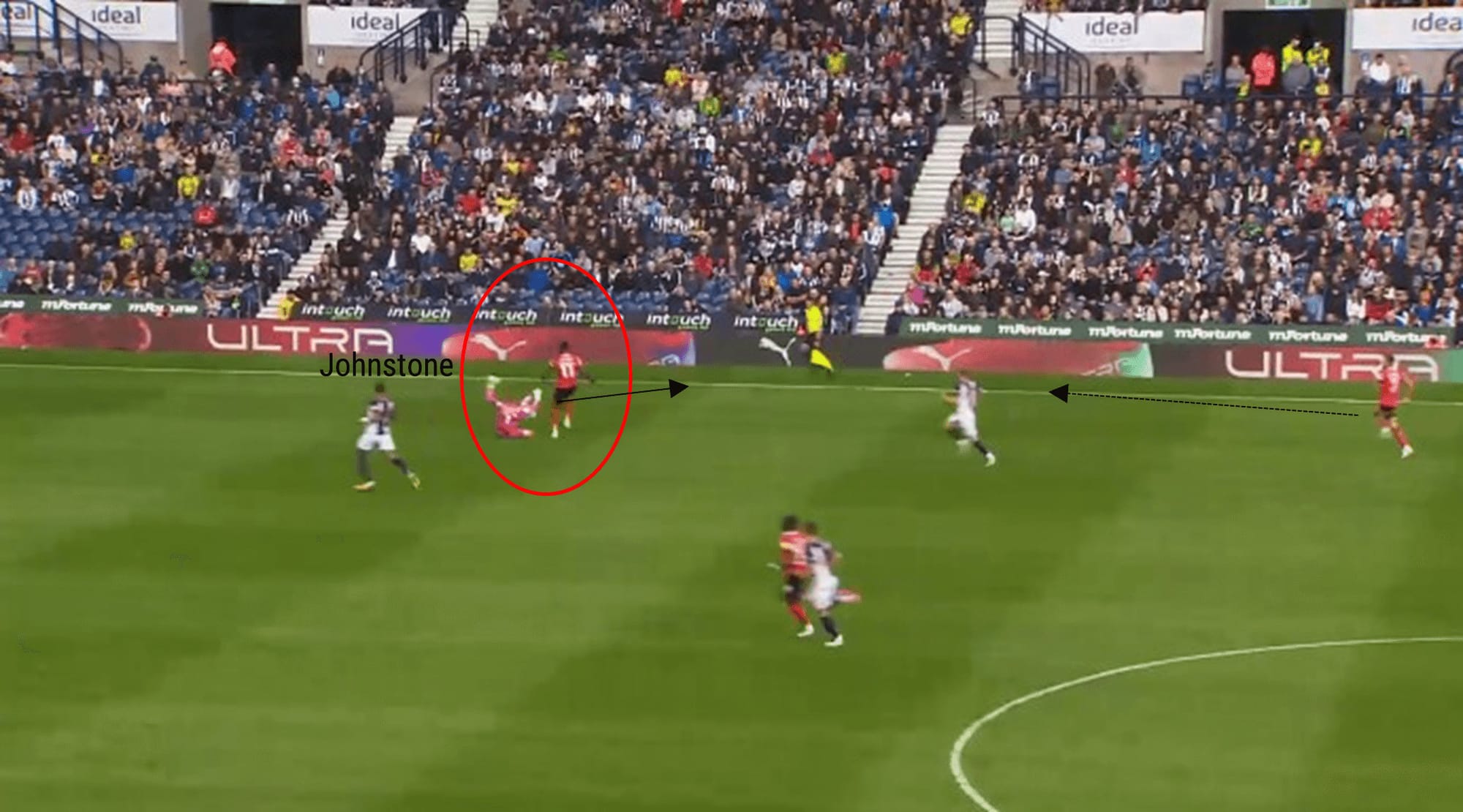
Johnstone timed his tackle well to come away with the ball.
However, the keeper could not get enough on the tackle to put the ball out for a throw-in, with another Luton attacker advancing.
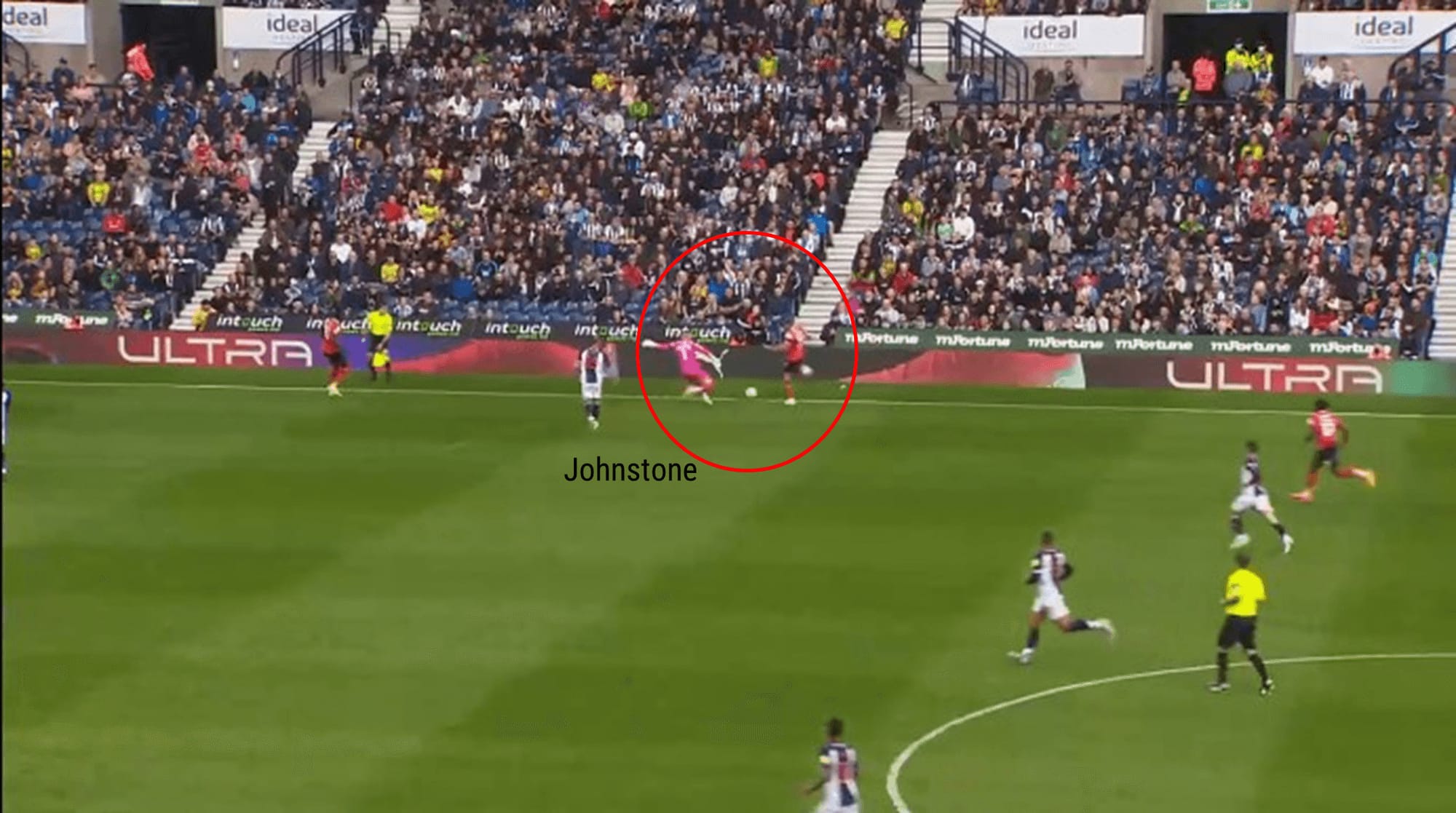
Johnstone was able to recover quickly, however, by getting to his feet to make another tackle.
This time, the ball went out of play, allowing West Brom to regain their defensive shape, and the counterattack was successfully halted.
Johnstone has accumulated more experience than Henderson in the EFL Championship over the years, representing Yeovil, Doncaster, Preston, Aston Villa, and West Brom.
During his time at Villa and the Baggies, he was part of promotion-vying sides and was able to help clinch promotion to the Premier League at the Hawthorns in the 2019/20 season.
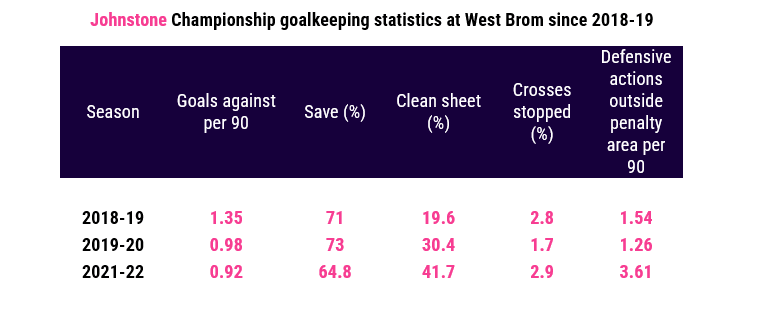
A review of the tables shows that at the Championship level, Henderson mostly outperformed Johnstone’s stint at West Brom.
Henderson conceded fewer goals per 90, kept a higher percentage of clean sheets, and stopped a higher rate of crosses.
The save percentage was comparable for the two goalkeepers.
Henderson has made 67 Premier League appearances, slightly more than Johnstone’s 52 appearances.
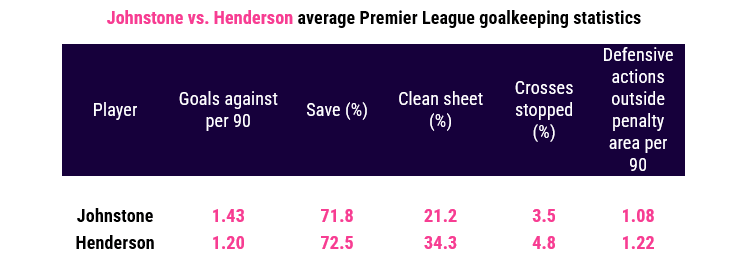
The table shows that not much separates the two goalkeepers in their average Premier League performances.
It is noticeable, however, that Henderson has kept 13.1% more clean sheets in the top flight, and it is suggested that he is more vital in stopping crosses.
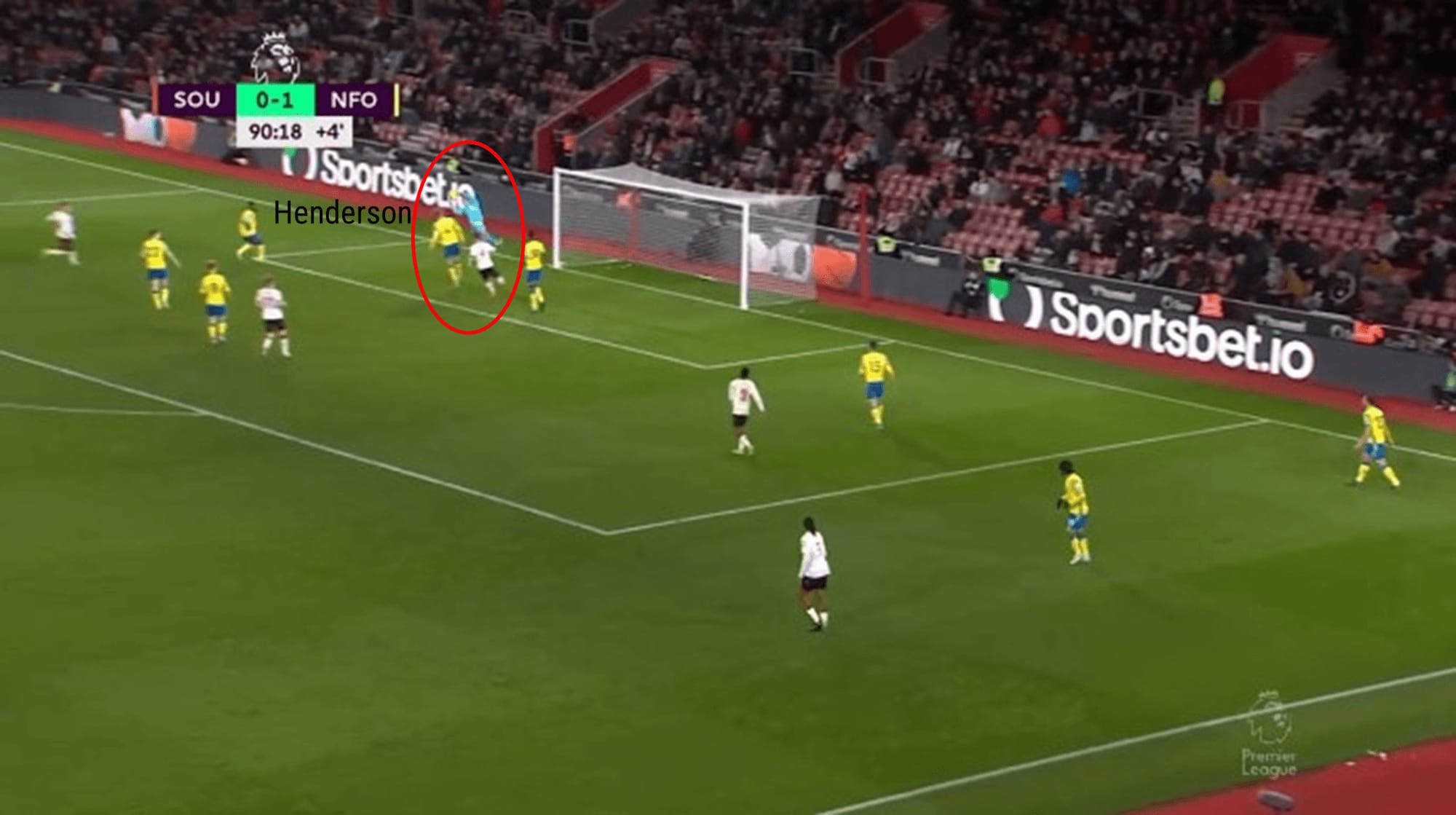
The ball is played in deep from the right-hand side, and Henderson can collect the ball.
Although Henderson is unopposed by the opposition attack here, he has still been able to catch the ball despite it being behind him, which is a testament to his athleticism.
Although Henderson is strong at stopping crosses, his tendency to punch the ball rather than catch it is a critique.
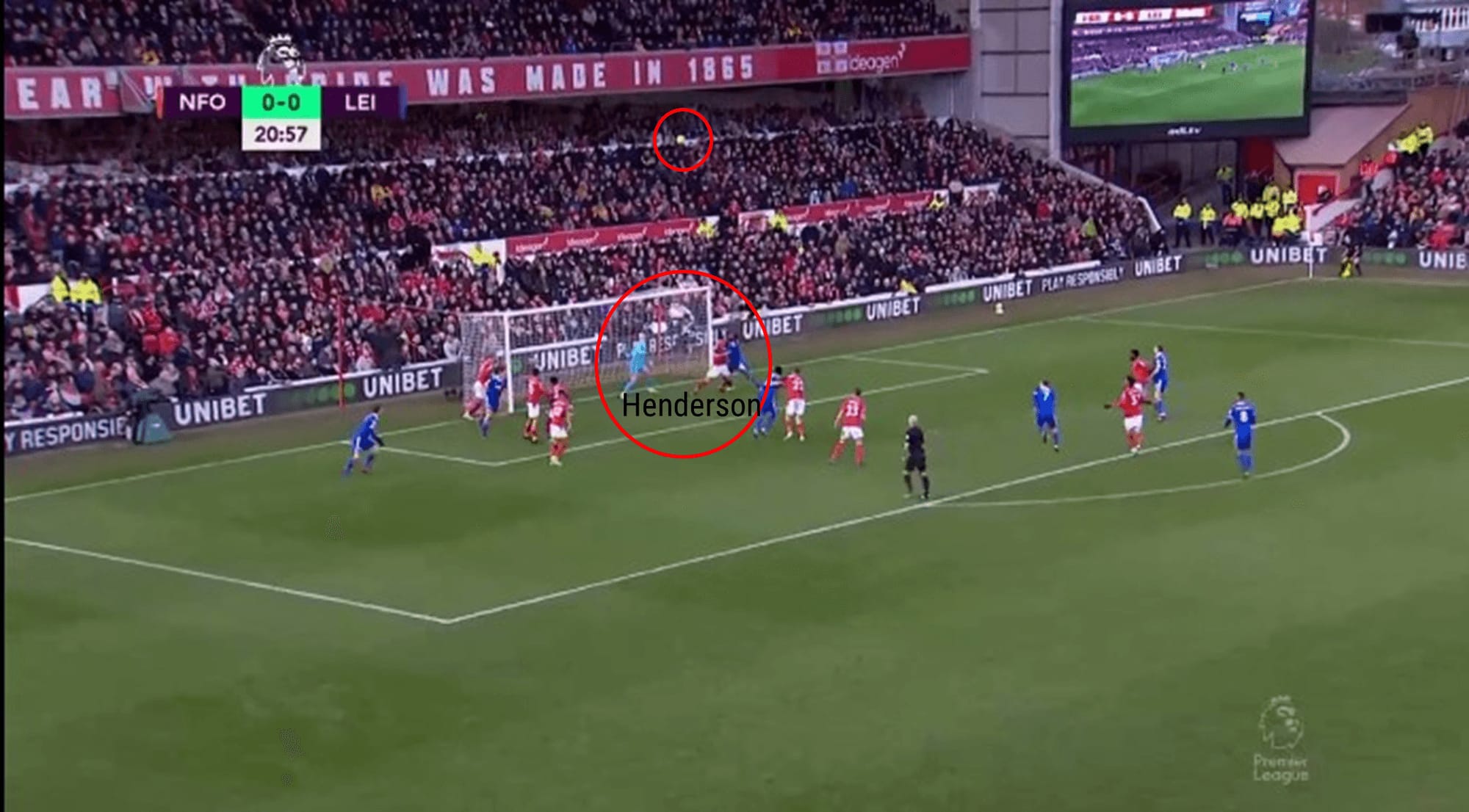
In the above image, Leicester have swung a corner in, and the ball is dropping towards Henderson’s path.
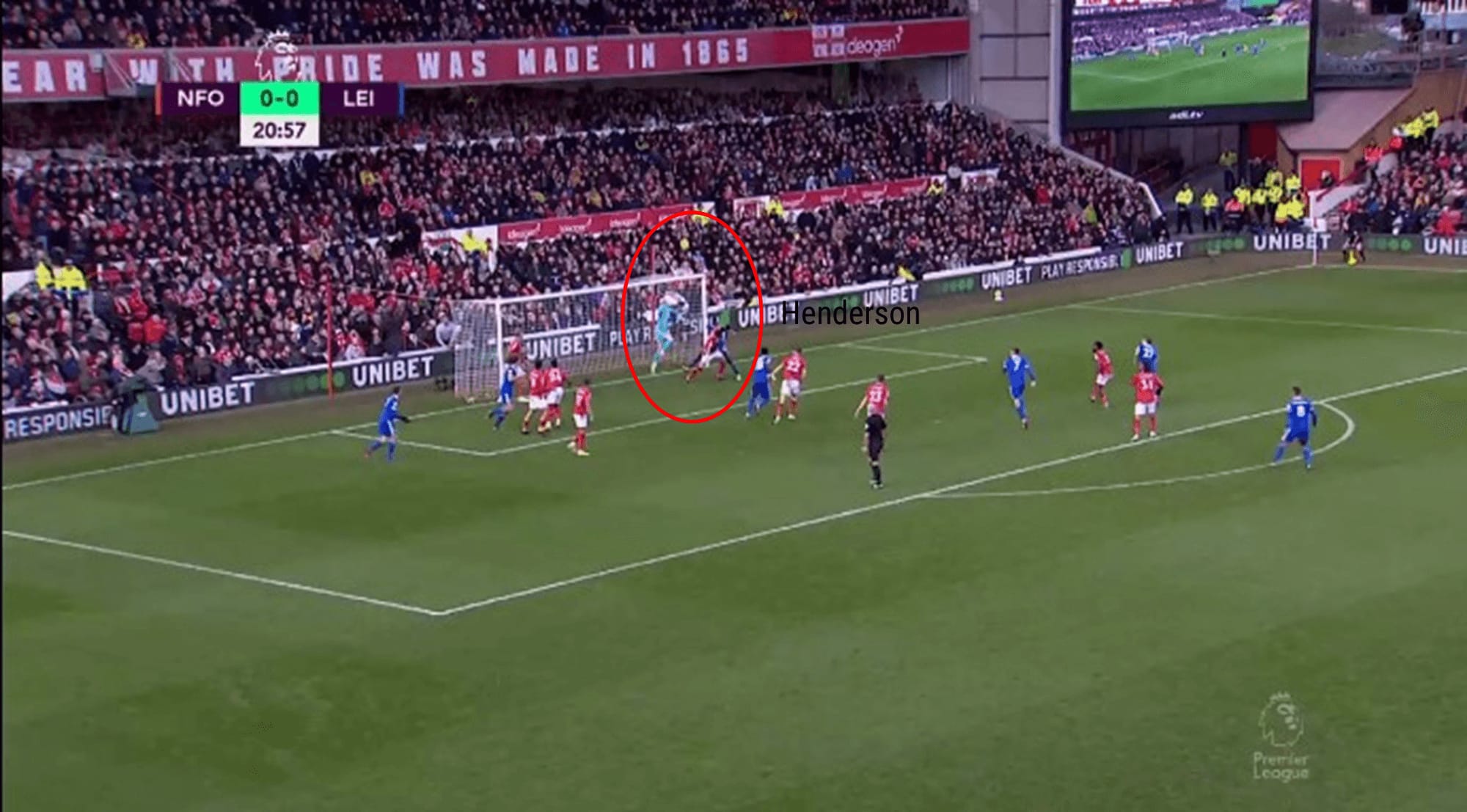
As the ball drops, the Forest defender is holding off the Leicester attacker well, leaving Henderson ample room to collect the ball.
However, the keeper opts to punch the ball clear and give possession back to the opposition in the process.
This represented a missed opportunity for Forest to gain possession.
Nevertheless, Henderson did avert the danger.
In addition to Henderson’s strengths in stopping crosses, he has a strong record in penalty saves.
Throughout his career, he has saved a third of the penalties he has faced.
Johnstone, in contrast, has only saved 15% of the penalties he’s faced despite having faced more.
However, this indicates that Henderson may be the preferred option for the domestic cup competitions, where penalty shoot-outs are a strong prospect, especially given the omission of extra time.
In addition to the physical attributes required of goalkeepers, an important attribute to consider in the modern game is their ability when in possession.
Possession play important
Under Hodgson, Palace vary their approach to goal kicks, either playing out from the back or opting to launch the ball.
In the case of the former, the first phase of play is with the goalkeeper looking to play the ball out to the defence.
It’s, therefore, important that the goalkeeper is comfortable when in possession.
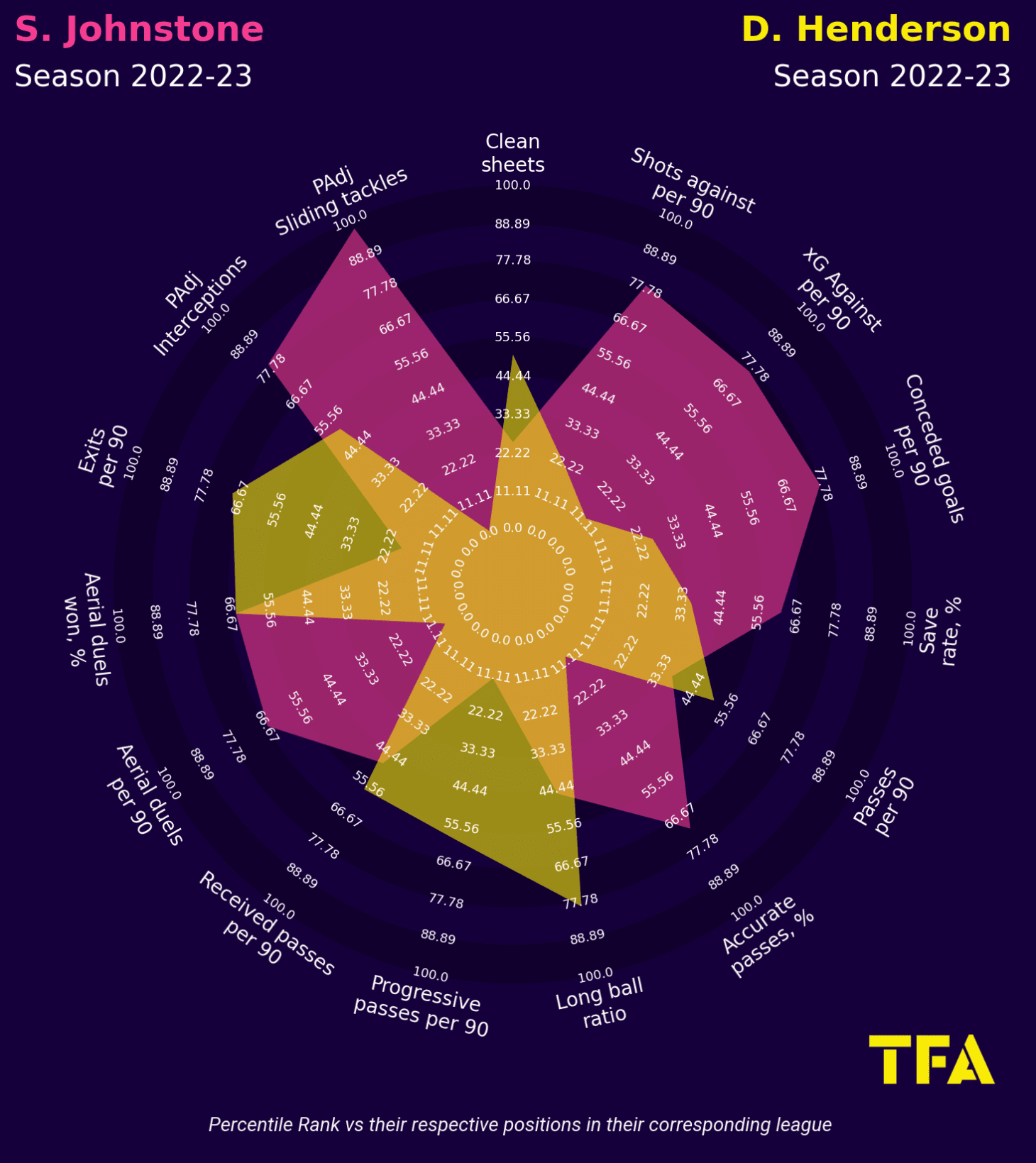
The radar chart shows that Johnstone was much more adept in regaining possession than Henderson last season, as he ranked much higher for possession-adjusted interceptions and tackles.
He also ranked higher for percentage of accurate passes.
Under the guidance of Darren Moore at West Brom in the 2018/19 campaign, Johnstone developed his possession play.
This suggests that Johnstone has been able to adapt his game in cohesion with the modern game.
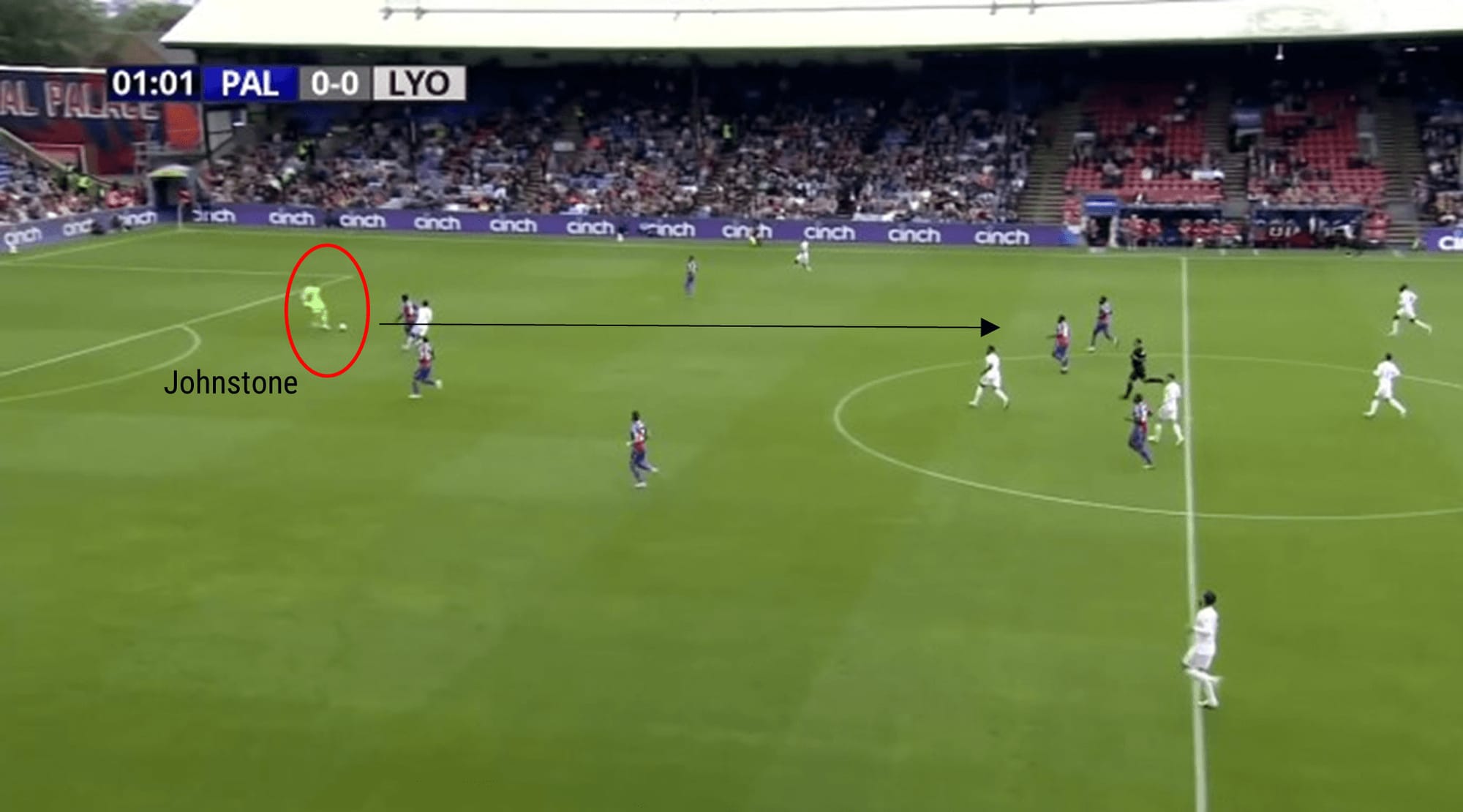
In this instance, Johnstone has demonstrated his ability to break up play by intercepting the pass.
The 30-year-old was then able to show composure by passing into the midfield.
The above image suggests a calmness and intelligence in Johnstone’s play.
Furthermore, it indicates that Johnstone is comfortable leaving the penalty area in order to complete defensive duties.
The previous radar chart also showed the solid passing credentials of Johnstone.
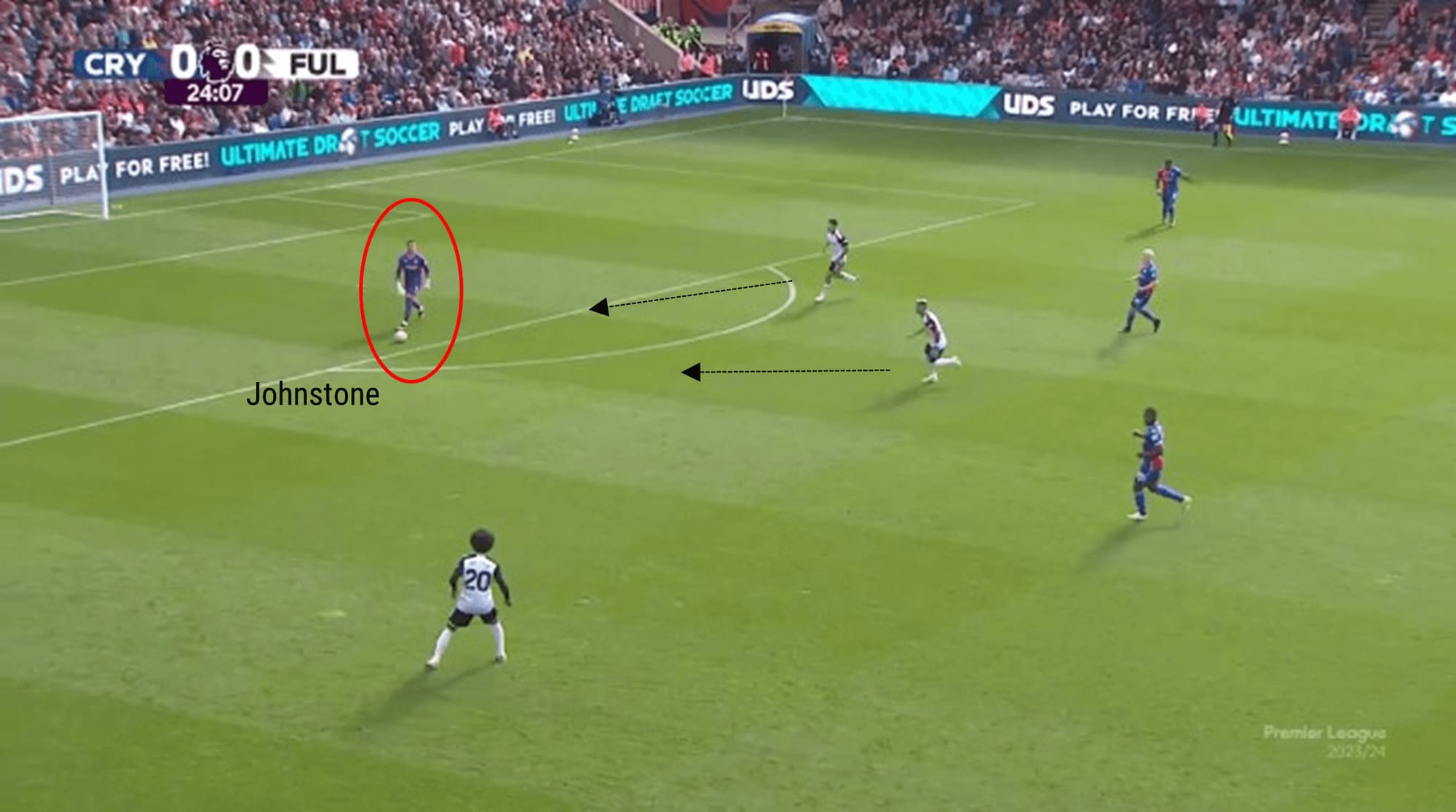
Fulham have a high press with two attackers heading towards Johnstone to put him under pressure.
However, Johnstone showed composure to chip the ball over the opposition towards Joel Ward, who was positioned just short of the halfway line.
Palace were subsequently able to advance play forward.
The previous radar chart showed that Henderson ranked higher for long ball ratio.
It is, therefore, conceivable that Henderson’s lack of accurate passing is more attributed to the type of passing by the former Forest keeper.
This in itself is a product of Forest’s style of play under Steve Cooper, as only three teams had a higher percentage of goal kicks launched more than 40 yards last season.
Although in comparison to goalkeepers who played at least 10 matches, Henderson ranked fifth in the division last campaign for successful passes into the final third per 90.
This coincides with the radar chart for Henderson’s high ranking of progressive passes per 90.
These impressive statistics may prove valuable for Palace in advancing play further up the pitch, as they are currently the lowest scorers in the top half of the Premier League.
Henderson has shown, though, that he also has accurate distribution.
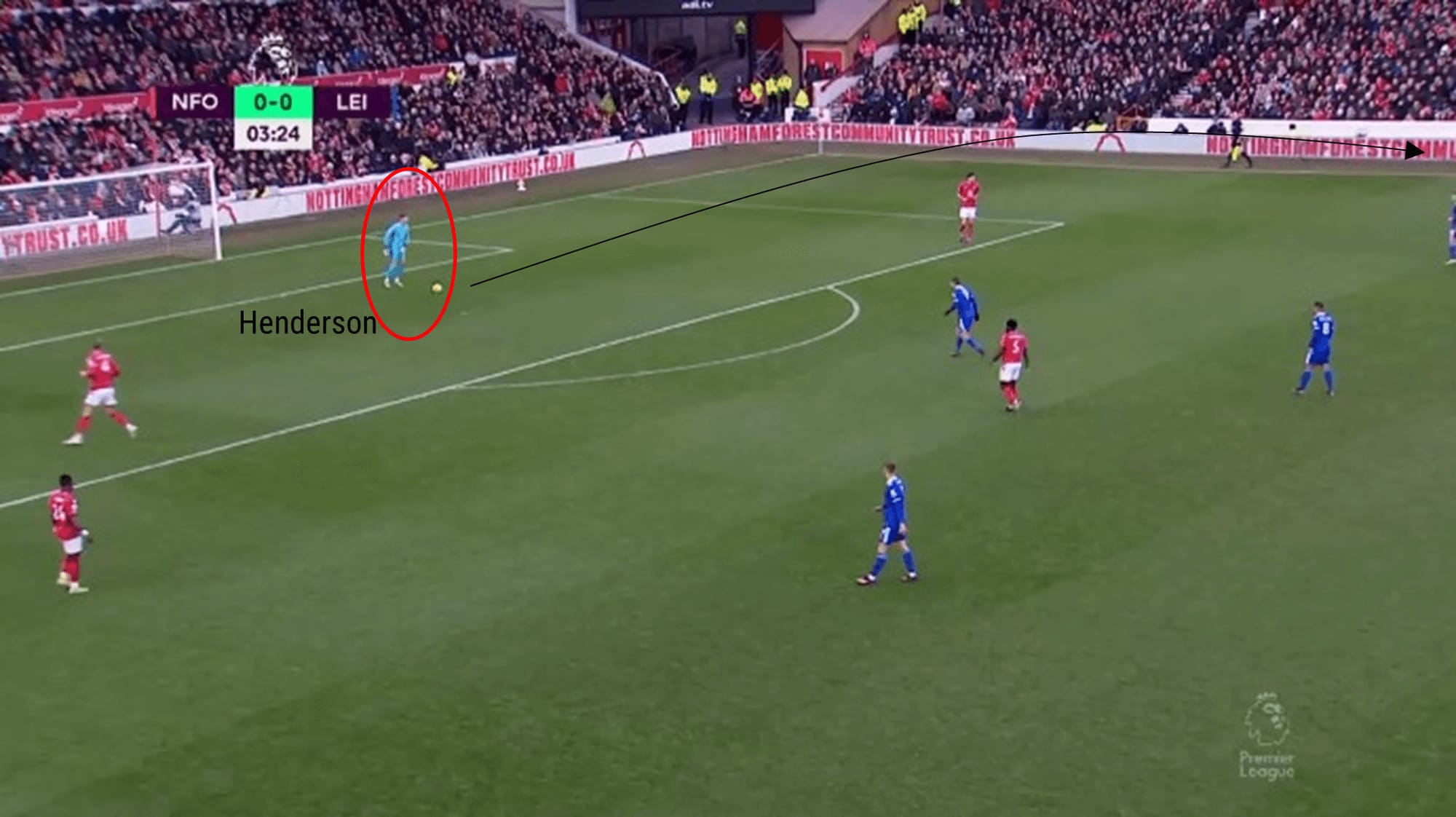
In the graphic, Henderson is in control of the ball with a few options as the Forest defence are positioned close by.
However, Henderson opts for the more difficult pass by lofting the ball over to the left-hand side near the halfway line.
His teammate is able to control the ball, and Forest advance their attack.
It is shown that Henderson has similar passing distribution credentials to Johnstone, but he did not rank as high as Johnstone for the possession-adjusted defensive actions.
He has, though, markedly improved this aspect of his game.
In his first season at Sheffield United, he completed 0.3 sweeper actions per 90 compared to 1.5 sweeper actions per 90 whilst at Forest.
Like Johnstone, there is an indication that Henderson is adapting.
Such adaptation and improvement will be essential if Henderson is to displace Johnstone.
While there is room for improvement with both goalkeepers, there doesn’t appear to be much that separates them.
Johnstone will know he must continue to impress to hold onto his place in the starting line-up.
Henderson will equally be aware that, given any opportunity, he will have to impress to make his own number one jersey.
Conclusion
In this tactical analysis, we discussed the positive influence that Johnstone has had on the Crystal Palace backline.
We have seen that Johnstone’s performances in this current season are above average for goalkeepers in the league, suggesting the difficult job that Henderson will have to become Hodgson’s first choice.
However, this analysis has compared the two goalkeeping options and highlighted the differences between the two in the more recent Championship seasons and the Premier League.
Whilst Johnstone and Henderson are relatively similar in some departments based on past performances, the former Sheffield United loanee edges his rival in some attributes and vice versa.
This analysis has further highlighted the possession aspects of the respective goalkeepers to determine their suitability in Hodgson’s Palace side.
There is no doubt that Henderson has aspirations to finally nail down a place in the starting XI each week, but it will be a tough ask for the 26-year-old.
However, no matter who takes the gloves at Selhurst Park, there is no doubt that Palace are in safe hands.






Comments